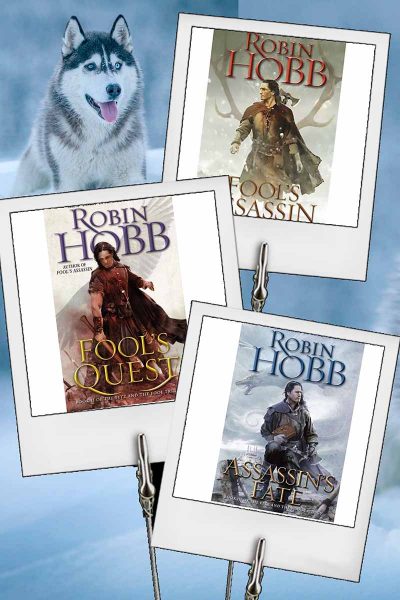 In the dedication page of “Assassin’s Fate
In the dedication page of “Assassin’s Fate ,” the final installment of “The Fitz and The Fool Trilogy,” Robin Hobb wrote, “To Fitz and The Fool, my best friends for over 20 years.”
As a reader, I felt the same way having read the first book in the first trilogy way back in 1995 when it was first released. Twenty-two years later, I found myself re-reading that first 8 books in the three trilogies in anticipation of reading the final installment.
But before I continue, I have to warn you that there will be spoilers here for all the 9 books about the Farseers. Below is a photo of a wolf. Anything below it, read at your own risk because spoilers abound.
 FitzChivalry has always pulled at my heartstrings since he was 6 years old when he was introduced to the Six Duchies royalty as a bastard child of King-in-Waiting Chivalry Farseer. The first trilogy, “The Farseer” followed Fitz as a young boy of 6 until he was a young man in his 20s. The second set, “The Tawny Man Trilogy,” Fitz was the at prime of his life in his 30s and 40s. And the here at “The Fitz and The Fool” trilogy, we see Fitz in his 50s and 60s.
FitzChivalry has always pulled at my heartstrings since he was 6 years old when he was introduced to the Six Duchies royalty as a bastard child of King-in-Waiting Chivalry Farseer. The first trilogy, “The Farseer” followed Fitz as a young boy of 6 until he was a young man in his 20s. The second set, “The Tawny Man Trilogy,” Fitz was the at prime of his life in his 30s and 40s. And the here at “The Fitz and The Fool” trilogy, we see Fitz in his 50s and 60s.
I have read several mega epics. And like the story of FitzChivalry which took 22 years to finish, those books also took decades before it concluded. But, unlike FitzChivalry who actually grew old, the other heroes stayed young because the events in their stories only happened in a few years instead of decades.
And that is also one of the reasons why FitzChivalry has stood out as a fictional hero for me. I felt as if we grew old together. My young self in 1995 could relate to the young Assassin’s Apprentice. While my older self in 2017 can relate to the travails of parenthood.
In “Assassin’s Fate,” Fitz has to face his mortality. And in this journey, we see his strengths and his weaknesses. We see his capacity for love, even his capacity for anger, even hate. But, most of all, we see him as a parent who loves his children. As a reader, I see him as successful. But, Fitz sees himself as a failure.
That is why this final book is so heart wrenching. For readers like me who “grew up” with Fitz, I too have to look myself in the mirror and ask myself what I have done in the past two decades. And, like Fitz, sometimes I like what I see, sometimes I don’t.
Fitz is so human! Robin Hobb had created him to be so. So, saying goodbye to him in “Assassin’s Fate ” was so hard for me. I cried so much in the last half of the book that in the final chapter, when Bee Farseer said that “they were not crying anymore because they don’t have any more tears,” I had to concur. By the time I read the final chapter, I was so emotionally drained, I could not cry anymore.
If I was heartbroken saying goodbye to Fitz, I had very ambivalent feelings about The Fool a.k.a. the White Prophet Beloved. Even when they were boys together at Buck Keep Castle, I found The Fool interesting but never lovable. In fact, it took me some time before I realized that he was a main character!
And though the second set of books, “The Tawny Man” trilogy was all about The Fool, I remained emotionally unmoved by him. And, then of course, when he took the Amber persona and started to act like a woman, I began to dislike him and actively hate him when he inferred to others that Amber was Bee’s mother and completely disregarded Molly.
Still, it is with The Fool that I fully realized Robin Hobb’s genius as a writer. As my dislike for The Fool/Amber grew, Robin Hobb echoed that feelings on Fitz. It was as if Fitz was feeling the same way I felt. Of course, Fitz and I parted ways on how he felt about The Fool. Fitz saw him as his friend, though I have always seen The Fool as someone who used Fitz.
When my feeling of Fool’s betrayal of Fitz was vocalized by Bee, I realized then that Robin Hobb has always been in control of the story. She was shepherding her readers exactly where she wanted them to be. Genius!!! Or to use the vernacular, its wicked!
Not surprisingly, Nighteyes, Fitz’s bond animal became the foil to The Fool’s betrayal of Fitz’s friendship. Already a shadow or perhaps a spirit who just lived in Fitz’s head or sometimes Bee’s, Nighteyes continued to be loyal and true. A friend to Nettle and whom Bee calls Wolf Father, Nighteyes is Fitz’s truest friend.
So choosing a wolf form as their “dragon” was actually a rational choice. And that brings us to an ending that sounded as a beginning also.
The final chapter of “Assassin’s Fate ” gave hints that Bee, Spark, Perseverance, Lant and even Hap still have stories to tell. I can only hope that we have not seen the last of the Farseers.
-
Assassin's Fate


